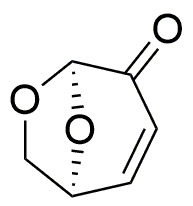Levoglucosenone is widely utilized in research focused on:
- Biomass Conversion: It serves as a key intermediate in the conversion of biomass into valuable chemicals, enhancing the sustainability of biofuel production.
- Synthesis of Fine Chemicals: This compound is used in the synthesis of various fine chemicals, including pharmaceuticals, due to its unique reactivity and structural features.
- Polymer Production: Levoglucosenone can be employed in the development of biodegradable polymers, contributing to environmentally friendly materials in packaging and other applications.
- Flavor and Fragrance Industry: It is utilized in the formulation of flavors and fragrances, providing a natural alternative to synthetic compounds.
- Research in Green Chemistry: The compound is a subject of study in green chemistry initiatives, promoting the development of eco-friendly chemical processes and reducing environmental impact.
General Information
Properties
Safety and Regulations
Applications
Levoglucosenone is widely utilized in research focused on:
- Biomass Conversion: It serves as a key intermediate in the conversion of biomass into valuable chemicals, enhancing the sustainability of biofuel production.
- Synthesis of Fine Chemicals: This compound is used in the synthesis of various fine chemicals, including pharmaceuticals, due to its unique reactivity and structural features.
- Polymer Production: Levoglucosenone can be employed in the development of biodegradable polymers, contributing to environmentally friendly materials in packaging and other applications.
- Flavor and Fragrance Industry: It is utilized in the formulation of flavors and fragrances, providing a natural alternative to synthetic compounds.
- Research in Green Chemistry: The compound is a subject of study in green chemistry initiatives, promoting the development of eco-friendly chemical processes and reducing environmental impact.
Documents
Safety Data Sheets (SDS)
The SDS provides comprehensive safety information on handling, storage, and disposal of the product.
Product Specification (PS)
The PS provides a comprehensive breakdown of the product’s properties, including chemical composition, physical state, purity, and storage requirements. It also details acceptable quality ranges and the product's intended applications.
Certificates of Analysis (COA)
Search for Certificates of Analysis (COA) by entering the products Lot Number. Lot and Batch Numbers can be found on a product’s label following the words ‘Lot’ or ‘Batch’.
*Catalog Number
*Lot Number
Certificates Of Origin (COO)
This COO confirms the country where the product was manufactured, and also details the materials and components used in it and whether it is derived from natural, synthetic, or other specific sources. This certificate may be required for customs, trade, and regulatory compliance.
*Catalog Number
*Lot Number
Safety Data Sheets (SDS)
The SDS provides comprehensive safety information on handling, storage, and disposal of the product.
DownloadProduct Specification (PS)
The PS provides a comprehensive breakdown of the product’s properties, including chemical composition, physical state, purity, and storage requirements. It also details acceptable quality ranges and the product's intended applications.
DownloadCertificates of Analysis (COA)
Search for Certificates of Analysis (COA) by entering the products Lot Number. Lot and Batch Numbers can be found on a product’s label following the words ‘Lot’ or ‘Batch’.
*Catalog Number
*Lot Number
Certificates Of Origin (COO)
This COO confirms the country where the product was manufactured, and also details the materials and components used in it and whether it is derived from natural, synthetic, or other specific sources. This certificate may be required for customs, trade, and regulatory compliance.


